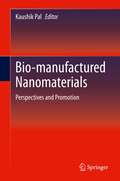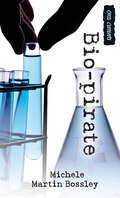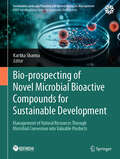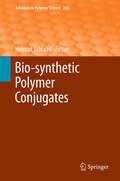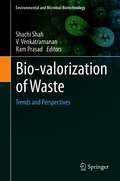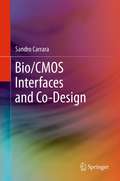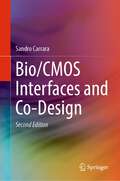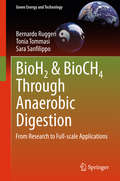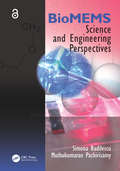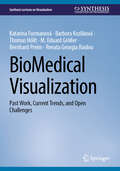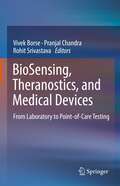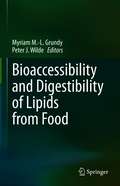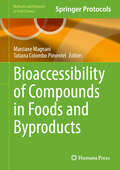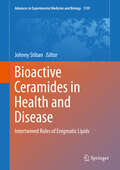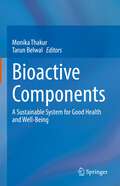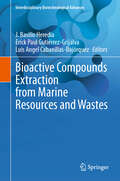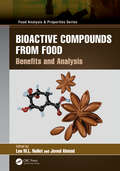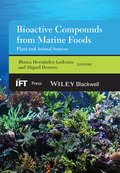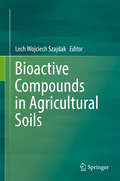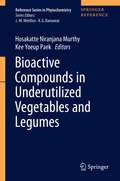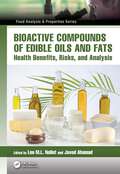- Table View
- List View
Bio-manufactured Nanomaterials: Perspectives and Promotion
by Kaushik PalThis book is based on the principles, limitations, challenges, improvements and applications of nanotechnology in medical science as described in the literature. It highlights various parameters affecting the synthesis of bio-nanomaterials and exclusive techniques utilized for characterizing the nanostructures for their potential use in biomedical and environmental applications. Moreover, biodegradable synthesis of nanomaterials is regarded as an important tool to reduce the destructive effects associated with the traditional methods of synthesis for nanostructures commonly utilized in laboratory and industry and as well as academic scale of innovative research foundation.
Bio-pirate (Orca Currents)
by Michele Martin BossleyTrevor, Robyn and Nick decide they have a mystery to solve when Trevor discovers a suspicious looking young man snooping around. They learn about missing research involving the use of carob beans to aid in cancer treatment-potentially valuable information. With a shady looking grad student, a bitter activist and an employee of a medical research firm to deal with, our amateur sleuths are faced with their greatest challenge yet.
Bio-prospecting of Novel Microbial Bioactive Compounds for Sustainable Development: Management of Natural Resources Through Microbial Conversion into Valuable Products (Sustainable Landscape Planning and Natural Resources Management)
by Kartika SharmaThis book discusses current developments and upcoming trends in the microbial synthesis of various bioactive compounds from waste product which have a very good market worldwide. The extraction of biologically active compounds from microorganisms is still essential for the creation of novel pharmaceuticals and agricultural chemicals, and has underpinned their application as drugs and functional food ingredients. The demand of pharmaceuticals, nutraceuticals and agrochemicals is rising globally for the multi-billion dollar market of human disease prevention and treatment. However, the limitations and issues associated with the extraction of these bioactive compounds from natural resources, such as plants, animals, or fungi, limit the large-scale use of pharmaceuticals, nutraceuticals, and agrochemicals. The microbial production of agrochemicals, nutraceuticals, and pharmaceuticals by utilizing by utilizing waste product is now thought to be an environmentally benign process. The major goal of this book is to draw attention to excellent original research and review articles that contain cutting-edge characterization techniques and novel bioactive chemicals production that make important contributions to the field with many prospective applications. In this book, the potential for using microbial bioactive compounds which have positive health effects in their entirety is highlighted. This book is written by eminent scientists from around the world and seasoned researchers, thoroughly discusses current developments and patterns in the microbial synthesis of bioactive compounds. Academicians, scientists, researchers, graduate and post-graduate students who work in the highly dynamic and competitive fields of pharmaceuticals, nutraceuticals, and agrochemicals discovery will find this book to be ideal.
Bio-synthetic Polymer Conjugates (Advances in Polymer Science #253)
by Helmut SchlaadPolypeptide-Polymer Conjugates, by Henning Menzel Chemical Strategies for the Synthesis of Protein-Polymer Conjugates, by Björn Jung and Patrick Theato Glycopolymer Conjugates, by Ahmed M. Eissa and Neil R. Cameron DNA-Polymer Conjugates: From Synthesis, Through Complex Formation and Self-assembly to Applications, by Dawid Kedracki, Ilyès Safir, Nidhi Gour, Kien Xuan Ngo and Corinne Vebert-Nardin Synthesis of Terpene-Based Polymers, by Junpeng Zhao and Helmut Schlaad
Bio-valorization of Waste: Trends and Perspectives (Environmental and Microbial Biotechnology)
by Ram Prasad Shachi Shah V. VenkatramananThis book explores the concept and methods of waste management with a new approach of biological valorization. Waste valorization is a process that aims to reduce, reuse, and recycle the waste into usable, value-added, and environmental benign raw materials which can be a source of energy. The book brings together comprehensive information to assert that waste can be converted into a resource or a raw material for value addition. Waste valorization imbibes the natural recycling principles of zero waste, loop closing, and underlines the importance of sustainable and environmentally friendly alternatives. Drawing upon research and examples from around the world, the book is offering an up-to-date account, and insight into the contours of waste valorization principles, biovalorization technologies for diverse group of wastes including agricultural, municipal, and industrial waste. It further discusses the emerging paradigms of waste valorization, waste biorefineries, valorization technologies for energy, biofuel, and biochemical production. The book meets the growing global needs for a comprehensive and holistic outlook on waste management. It is of interest to teachers, researchers, scientists, capacity builders and policymakers. Also, the book serves as additional reading material for undergraduate and graduate students of biotechnology and environmental sciences.
Bio/CMOS Interfaces and Co-Design
by Sandro CarraraThe application of CMOS circuits and ASIC VLSI systems to problems in medicine and system biology has led to the emergence of Bio/CMOS Interfaces and Co-Design as an exciting and rapidly growing area of research. The mutual inter-relationships between VLSI-CMOS design and the biophysics of molecules interfacing with silicon and/or onto metals has led to the emergence of the interdisciplinary engineering approach to Bio/CMOS interfaces. This new approach, facilitated by 3D circuit design and nanotechnology, has resulted in new concepts and applications for VLSI systems in the bio-world. This book offers an invaluable reference to the state-of-the-art in Bio/CMOS interfaces. It describes leading-edge research in the field of CMOS design and VLSI development for applications requiring integration of biological molecules onto the chip. It provides multidisciplinary content ranging from biochemistry to CMOS design in order to address Bio/CMOS interface co-design in bio-sensing applications.
Bio/CMOS Interfaces and Co-Design
by Sandro CarraraThis textbook demonstrates new paradigms for the interface between CMOS circuits and the biological world. A deep theoretical description of such an interface is defined and discussed, while various real applications are demonstrated by also discussing several analog CMOS circuits. Electrochemical techniques are proposed in detail to learn how to design integrated biosensors. Biological materials are described to provide devices selectivity. Nanoscale materials are discussed to provide device sensitivity. CMOS circuits are analyzed to provide real applications. Extensive examples with solutions are provided, as well as exercises at the end of each chapter. This book introduces students to the state-of-the-art in Bio/CMOS interfaces, describing leading-edge research in CMOS design and VLSI development for applications requiring intimate integration of biological molecules onto the chip. It provides multidisciplinary content ranging from biochemistry to CMOS design in order to address Bio/CMOS interface co-design in biosensing applications.
BioElectroMagnetics: Human Safety and Biomedical Applications
by Riadh HabashThis book is an educational resource of evolving scientific knowledge in the area of bioelectromagnetics that may serve the interests of students and decision-makers, as well as society as a whole. It is distinguished by extensive descriptions of fundamental biophysical concepts and their relevance to human health. Reflecting the transdisciplinary approach from several different intellectual streams including physics, biology, epidemiology, medicine, environment, risk science, and engineering, the book is quite a venture into the battling studies to assess the latest research on health effects and biomedical applications of EM energy. This new edition of the book particularly looks at the potential threats from the emerging 5G wireless networks, which will deploy large numbers of low-powered smartphones, notebooks, tablets, radio access networks, and other transmitters. Features Introduces necessary biophysical principles of EM fields in the context of their interaction with living systems. Strengthens understanding of cutting-edge research on several major areas in the broad area of bioelectromagnetics. Presents safety standards and guidelines for human exposure to EM fields. Discusses techniques that have been developed to ensure adequate EM-thermal dosimetry required for both health effects and biomedical applications. Provides insight into the determinants of EM health risk assessment and public concerns. Includes extensive reference list at the end of each chapter to enhance further study. Riadh Habash is a special appointment professor and McLaughlin Research Chair in Electromagnetic Fields and Health at the University of Ottawa, Canada. He has been the recipient of many awards, including the National Wighton Fellowship Award, and has authored or co-authored over 90 research articles, six books, and five book chapters. His most recent books are Green Engineering in 2017 and Professional Practice in 2019 (CRC Press), with the remaining previous books targeting the area of bioelectromagnetics.
BioH2 & BioCH4 Through Anaerobic Digestion: From Research to Full-scale Applications (Green Energy and Technology)
by Bernardo Ruggeri Tonia Tommasi Sara SanfilippoThis book presents a Two-Stage Anaerobic Digestion (TSAD) technique for producing hydrogen and methane, following a step-by-step approach in order to guide readers through the experimental verification of the related hypothesis. In the first stage of AD, the reaction conditions are optimized to obtain the maximum amount of hydrogen, while in the second the liquid residue from the first phase is used as a substrate to produce fuel-methane. AD has traditionally been used to reduce the organic content of waste; this results in a biogas that is primarily constituted of CH4 and CO2. Over the last few decades, the conversion of organic matter into hydrogen by means of AD and selecting Hydrogen Producing Bacteria (HPB) has matured into a viable and sustainable technology among the pallet of H2 generation technologies. The combined bio-production of hydrogen and methane from Organic Waste Materials (OWM) is considered to be an ideal way of utilizing waste, and can increase energy efficiency (the substrate Heat Value converted into H2 and CH4 fuel) to roughly 80%, since the energy efficiency of H2-production alone (15%) is not energetically competitive. The two gas streams can be used either separately or in combination (Hytane®), be supplied as civilian gas or used for transportation purposes. All the aspects of this sustainable technology are taken into account, from the basic biochemical implications to engineering aspects, establishing the design criteria and the scale-up procedures for full-scale application. The sustainability of the TSAD method is assessed by applying EROI (Energy Return On Investment) and EPT (Energy Payback Time) criteria, and both the general approach and application to the field of Anaerobic Digestion are illustrated.
BioMEMS: Biosensing Applications (Lecture Notes in Bioengineering)
by Samira Hosseini Michelle Alejandra Espinosa-Hernandez Ricardo Garcia-Ramirez Ana Sofia Cerda-Kipper Sofia Reveles-Huizar Luis Acosta-SotoThis book highlights the latest advances in bioMEMS for biosensing applications. It comprehensively reviews different detection methods, including colorimetric, fluorescence, luminescence, bioluminescence, chemiluminescence, biochemiluminescence, and electrochemiluminescence, and presents various bioMEMS for each, together with recent examples. The book also offers an overview of the history of BioMEMS and the design and manufacture of the first bioMEMS-based devices.
BioMEMS: Science and Engineering Perspectives
by Simona Badilescu Muthukumaran PackirisamyAs technological advancements widen the scope of applications for biomicroelectromechanical systems (BioMEMS or biomicrosystems), the field continues to have an impact on many aspects of life science operations and functionalities. Because BioMEMS research and development require the input of experts who use different technical languages and come f
BioMedical Visualization: Past Work, Current Trends, and Open Challenges (Synthesis Lectures on Visualization)
by Bernhard Preim Katarína Furmanová Barbora Kozlíková Thomas Höllt M. Eduard Gröller Renata Georgia RaidouThis book provides an overview of the many visualization strategies that have been proposed in recent decades for solving problems within the disciplines of medicine and biology. It also evaluates which visualization techniques applied to various areas of biomedicine have been the most impactful and which challenges can be considered solved using visualization. The topics covered in this book include visualization research in omics, interaction networks and pathways, biological structures, tumor diagnosis and treatment, vasculature, brain, surgery, educational contexts, therapy and rehabilitation, electronic health records, and public health. One chapter is dedicated to general visualization techniques commonly used for biomedical data, such as surface and volume rendering, as well as abstract and illustrative approaches. For each of these areas, the past and present research trends are discussed, highlighting the influential works. Furthermore, the book explains how research is affected by developments in technology, data availability, and domain practice. Individual sections also summarize the typical target users, the nature of the data, and the typical tasks addressed in the given domain. With a uniquely broad scope, the book identifies research trends in biomedical visualization using a manually curated and searchable repository of more than 3,800 publications. The resultant trends are further categorized according to the application field and using natural language processing. The book also utilizes 16 interviews conducted with researchers in the field of biomedical visualization for the purpose of soliciting their opinions regarding the evolution and trends in the domain. The book handles these topics in a concise manner to help readers orient themselves in the already mature and diverse field of biomedical visualization without overwhelming them with technical details. As such, the book can help young researchers to become familiar with past challenges and identify future ones. For more senior researchers, it can serve as an insightful overview of the research field and the direction in which it is heading.
BioSensing, Theranostics, and Medical Devices: From Laboratory to Point-of-Care Testing
by Rohit Srivastava Pranjal Chandra Vivek BorseThis book provides up-to-date information on the prototypes used to develop medical devices and explains the principles of biosensing and theranostics. It also discusses the development of biosensor and application-orientated design of medical devices. In addition to summarizing the clinical validation of the developed techniques and devices and the regulatory steps involved in their commercialization, the book highlights the latest research and translational technologies toward the development of point-of-care devices in the health care. Lastly, it explores the current opportunities, challenges and provides troubleshooting on the use of biosensors in precision medicine. The book is helpful for researchers and medical professionals working in the field of clinical theranostics, and medical-device development wanting to gain a better understanding into the principles and processes involved in the development of biosensors.
BioWare: Stories and Secrets from 25 Years of Game Development
by BiowareFrom the BioWare's isometric role-playing roots to its intense space operas and living worlds, chart the legendary game studio's first 25 years in this massive retrospective.BioWare - Stories and Secrets from 25 Years of Game Development puts you in the room during key moments in BioWare's history, with never-before-seen art and photos anchored by candid stories from developers past and present. See what it took to make games in those wild early days. Pore over details of secret, cancelled projects. Discover the genesis of beloved characters and games. Presented and designed by Dark Horse Books, this tribute to BioWare's legacy is a must-have for any fan of the best stories you can play.
Bioaccessibility and Digestibility of Lipids from Food
by Myriam M.-L. Grundy Peter J. WildeThe structure of a food influences the way it is transformed during processing and digestion. This in turn has an impact on nutrient bioaccessibility (release) and digestibility, and subsequently on the physiological response and health of the individual who consumes that food. Although evidence exists on the health benefits associated with the inclusion of certain lipid-rich foods (e.g. nuts, dairy products and fish) in the diet, the mechanisms that explain the physiological effects and the long-term benefits are not well understood. Lipids in themselves have many beneficial health effects: they are a source of energy and essential fatty acids, they are structural components of cell membranes, they are required to solubilise fat soluble compounds, and they serve as precursors of hormones. In addition, the overall structure of the food containing the lipids plays a crucial role in determining health benefits, notably by influencing lipid bioaccessibility and digestibility. Bioaccessibility and digestibility of lipids from food uniquely focuses on the physico-chemical properties of lipids and lipid rich food, as well as the subsequent effects on human health. Chapters from experts in food digestion examine food structure at both the macro- and micro- levels, covering lipids from plant and animal food products. The editors have developed the book for dietitians, nutritionists, and food scientists. Clinicians and other health professionals, educators in nutrition, and others working in the food industry will also find the material relevant.
Bioaccessibility of Compounds in Foods and Byproducts (Methods and Protocols in Food Science)
by Marciane Magnani Tatiana Colombo PimentelThis volume provides detailed and comprehensive descriptions of the methodologies and procedures used to evaluate bioaccessibility in different food compounds. Chapters focus on phenolics, minerals, carotenoids, fatty acids, and other bioactive molecules. Written in the format of the Methods and Protocols in Food Science series, chapters list necessary materials and methods for readily reproducible protocols. Authoritative and cutting-edge, Bioaccessibility of Compounds in Foods and Byproducts aims to be comprehensive guide for researchers in the field.
Bioactive Ceramides in Health and Disease: Intertwined Roles of Enigmatic Lipids (Advances in Experimental Medicine and Biology #1159)
by Johnny StibanThis book is about the various roles of bioactive ceramides and other sphingolipids in cellular biology. The enigmatic biophysical and biochemical properties of ceramides and their propensity to influence membranes whether as rafts or protein-permeable channels are heavily discussed. Metabolism of ceramides and their metabolites is also focused with ceramide synthase family of proteins being a target of extensive review. Ceramide 1-phosphate and other sphingolipids are also presented in cellular physiology and pathophysiology. Prokaryotic origins of mitochondria at the level of membranes and the occurrence of apoptosis in bacteria are presented. Many aspects of ceramide and sphingolipid biology are addressed in this book. Its focus is the metabolism of ceramide in normal and diseased states and the biophysical and biochemical mechanisms governing the bioactivity of these molecules. Sphingolipid research has surged over the past thirty years and this book gathers the recent findings of various aspects of sphingolipid biochemistry. World-renowned scientists from the field of lipid biology, specifically sphingolipid biochemistry, were gathered to write this book. Scholars from most continents of the globe committed to write diligently about their expertise and the newest findings in the relevant fields. This book came to fruition after almost a year and a half of laborious preparation and diligent writings. This book is targeted to the experienced reader who is looking to read about the various aspects of bioactive ceramide signaling, as well as to the newcomer into the field, as the topics are explained in concise yet very informative manner. The authors and editor wish all readers a pleasant time reading this volume, and are adamant that this book will meet all expectations.
Bioactive Components: A Sustainable System for Good Health and Well-Being
by Monika Thakur Tarun BelwalThis book compiles updated information about the role and health benefits of various bioactives in food. Different chapters are contributed by academicians, food scientists, technologists, and medical practitioners. The book addresses both theoretical and applied aspects of bioactive components and provides exhaustive knowledge about bioactive components. It comprises 27 chapters organized into 4 major sections covering topics in food science and technology, functional foods, and nutraceuticals. It provides perspectives for innovation, sources, applications, and sustainability in bioactive component research. The first section starts with introduction of bioactive components consisting of seven different chapters primarily focusing on the bioactive components and their sources with respective health benefits. The second section, comprising five different chapters, deals with different technological trends, regulations, and safety aspects of bioactive components. With eight chapters, the third section covers the role of bioactive components in human health and the role of functional foods in combating various health-related issues. The fourth section reviews functional foods through six chapters that cover the use of bioactive components in various food products. The book will prove useful to advanced food technology graduate and undergraduate students and research scholars, practicing food technologists in food and related industries, entrepreneurs, food-pharma researchers, and other scientists seeking information about smart and sustainable processes as well as information needed to design and develop these processes.
Bioactive Compounds Extraction from Marine Resources and Wastes (Interdisciplinary Biotechnological Advances)
by J. Basilio Heredia Erick Paul Gutiérrez-Grijalva Luis Angel Cabanillas-BojórquezThis book provides information about the principal biotechnological strategies (enzyme-assisted extraction, liquid fermentation, and solid-state fermentation) used for the bioactive compounds (bioactive peptides, carotenoids, phenolic acids, polyunsaturated fatty acids, vitamins, and minerals, among others) extraction from the marine resource (marine animals, microalgae, seaweed, among others) and wastes (crustaceans, fish, and others). This book also highlights the importance of bioactive compounds in marine resources and wastes and the perspectives for a potential industrial application. This book is oriented to researchers related to marine resources and marine wastes, who apply their knowledge in the innovation of the extraction and application of bioactive compounds from these sources. Moreover, this book will also provide knowledge and areas of opportunity for entrepreneurs, different industries, and the development of new products that could be used in the overall improvement of different areas such as human health.
Bioactive Compounds from Food: Benefits and Analysis (ISSN)
by Javed Ahmad Nollet, Leo M. L.A bioactive compound is a type of chemical found in small amounts in plants and certain foods (such as fruits, vegetables, nuts, oils, and whole grains). Bioactive compounds have actions in the body that may promote good health. They are widely explored and investigated for their role in the prevention and treatment of various diseases, including cancer, cardiovascular disorders, and neurodegenerative disorders; thus, they are categorized as nutraceuticals. Examples of such bioactive compounds from food include lycopene, resveratrol, lignan, tannins, and indoles. Accordingly, the methods that are utilized to analyze these compounds for their identification, detection, and characterization are of great interest.In Bioactive Compounds from Food: Benefits and Analysis, spectrophotometric, fluorometric, chromatographic, enzymatic, and electrophoretic methods that are utilized to analyze the different bioactive compounds of food are comprehensively discussed. In addition, the merits and limitations of the existing methods of analysis for bioactive compounds from food are also highlighted. Further, the benefits of these bioactive compounds on human health as anti-oxidative, anti-cancer, anti-diabetic, anti-inflammatory, anti-infective, anti-hyperlipidemic, and anti-hypertensive agents are also discussed with detailed insight and critical analysis of the contemporary research carried out in this domain.Key Features: Explores the world of bioactive compounds in foods Discusses recent analysis techniques for bioactive compounds Includes a summary of the health benefits of bioactive compounds Provides different analysis methods involved in the identification and quantification of food bioactive compounds This book provides in-depth information and a comprehensive discussion on the human health benefits of food bioactive compounds and the different methods of analysis involved in the identification and quantification of food bioactive compounds.
Bioactive Compounds from Marine Foods: Plant and Animal Sources (Institute of Food Technologists Series #64)
by Miguel Herrero Blanca Hernandez-LedesmaPart of the IFT Press series, this book reviews the myriad published information on bioactive components derived from marine foods, enabling researchers and product developers to select appropriate functional ingredients for new products. Chapters cover foods and food ingredients from both animal and plant marine sources, focusing on those which demonstrate biological properties and whose constituent compounds have been isolated and identified as potentially active. This book further addresses the biological activities of PUFAs (Polyunsaturated fatty acids), oils, phospholipids, proteins and peptides, fibres, carbohydrates, chitosans, vitamins and minerals, fucoxantin, polyphenols, phytosterols, taurine, amongst others. These components, found in a variety of marine-derived foods, have been demonstrated to have preventative properties with regard to hypertension, oxidative stress, inflammation, cardiovascular diseases, cancer and other human diseases. Extraction methods and analysis techniques are also addressed. Intended for food scientists, food technologists and food engineers in academia, industry and government, this book reviews the substantial quantity of current research in this fast-moving and commercially valuable sector of food and nutrition science.
Bioactive Compounds in Agricultural Soils
by Lech Wojciech SzajdakThis volume looks at the impact that different cropping systems and tillage have on soil's biologically active substances. It considers how phytotoxins accumulate and can inhibit the development of cultivated plants. Coverage explores the continuous cropping of rye, crop rotation, no tillage, and conventional tillage. It offers a comprehensive, comparative approach to allelopathic plant-soil interactions. The authors focus on free and bounded biologically active substances such as amino acids, auxins, humic and fulvic acids, transient radicals, and enzymes in light sand soils fertilized with different mineral and organic fertilizers. The chapters address fundamental questions relevant to the environmental challenges we face today and will deal with in the future. The results involve asking basic questions motivated by soil's chemical and biochemical processes. The answers will lead to the improvement of the quality of soil's organic matter, which, in turn, can lead to increased crop yields. Readers will come to understand the relationship between ecological processes and environmental change on individual levels of biocomplexity as well as on systems in their entirety. The title is ideal for students and teachers for laboratory practical classes. Soil scientists, biochemists, chemists, plant ecophysiologists, "Natural Products" organic chemists, and other environmental scientists and specialists will also find it useful.
Bioactive Compounds in Edible Mushrooms: Sustainability and Health Applications (Reference Series in Phytochemistry)
by Muhammad Akram Sylvester Chibueze Izah Matthew Chidozie OgwuThis handbook offers a comprehensive perspective of edible mushrooms' phytochemistry and explores the application of bioactive compounds from fungi in nutrition, medicine, and environmental sustainability. The book starts with an overview of edible mushrooms' bioactive compounds, followed by 5 parts covering the diversity, classification and taxonomy of common edible mushrooms, their environmental roles, sustainable harvesting practices, nutritional value and health benefits, and characterization and quality control of bioactive compounds. The book concludes with a perspective on emerging uses and trends in mushroom consumption utilization. In this book, readers will find valuable insights into the latest trends and developments in the field, including how diverse edible mushroom species are used in culinary, medicinal, and ecological contexts. Particular attention is given to functional foods and the chemical composition of an extensive range of bioactive compounds in edible mushrooms, such as beta-glucans, polysaccharides, ergosterol, phenolic compounds, and triterpenoids. The book also explores the environmental impact of mushroom cultivation and the economic opportunities arising from the increasing demand for edible mushrooms and their bioactive compounds. Techniques and strategies for preserving mushrooms, detecting adulteration in the mushroom market, characterizing bioactive compounds, and ensuring quality control in production and distribution are thoroughly discussed. This comprehensive overview serves as an invaluable resource for a wide range of professionals, including researchers, healthcare practitioners, nutritionists, food technologists, and anyone interested in tapping into the potential of edible mushroom bioactive compounds for the improvement of health, nutrition, and sustainability.
Bioactive Compounds in Underutilized Vegetables and Legumes (Reference Series in Phytochemistry)
by Hosakatte Niranjana Murthy Kee Yoeup PaekThis reference work provides a comprehensive overview of bioactive compounds found in underutilized vegetables and legumes around the globe. It describes their pharmacological, biological and health effects in detail, and provides a strategic framework for further research and global development activities. Using a consistent structure and divided into 9 parts based on the plant source, the book reviews bioactive compounds in various plant species. Each part opens with a leading article discussing the respective plant species. This book is a valuable reference resource for plant biologists and biotechnologists, pharmacologists, pharmacists, food technologists, nutritionists and other health professions working in academia and industry.
Bioactive Compounds of Edible Oils and Fats: Health Benefits, Risks, and Analysis (ISSN)
by Javed Ahamad M.L. Nollet, LeoEdible oils and fats are derived from plants and animals and have several health benefits. Edible oils and fats consist of many health-promoting bioactive compounds such as polyunsaturated fatty acids, monounsaturated fatty acids, polyphenols, flavonoids, phytosterols, vitamins, and inorganic compounds. The chemical compounds present in edible oils and fats are known for their possible health risks such as coronary heart disease and metabolic diseases, which is why there is a need to check the quality, purity, and safety of edible oils and fats. Bioactive Compounds of Edible Oils & Fats: Health Benefits, Risks, and Analysis provides an overview of different edible oils and fats, health benefits, associated risks, and analytical techniques for qualitative and quantitative guidelines for ensuring their quality and safety using modern analytical tools and techniques. This book will provide an important guideline for controlling quality, safety, and efficacy issues related to edible oils and fats.Key Features: Provides a detailed overview of different edible oils and fats of plant and animal origin, chemistry, and identification methods. Describes their health benefits, risks, and the use of different analytical techniques in quality control. Describes the applicability of sophisticated analytical techniques such as GC-FID, GC-MS, and HPLC for quality control of edible oils and fats. Emphasizes the use of recent techniques such as LC-MS and FTIR-chemometrics in the analysis and quality control of edible oils and fats.
